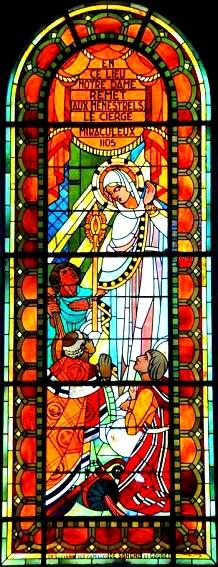Our Lady of Ardents

May 29: Our Lady of Ardents, Arras, France (1095)
The Abbot Orsini wrote: “A wax candle is kept in the cathedral of Arras, which is held to have been brought thither by Our Lady, in the year 1095.”
Our Lady of Ardents, or Eglise Notre-Dame des Ardents d’Arras in French, is a small, charming red brick church in the lower part of town in Arras, France. It was built in the beautiful style unique to the twelfth century in order to celebrate the appearance of the Blessed Virgin, and to commemorate the miraculous assistance she gave to the people then living in the region.
According to Tradition, there was a terrible epidemic that was given the name ‘the hellfire’ that ravaged the countryside in that year of 1105, and all men felt that they were in the clutch of the specter of Death. The Evil of Ardent, the disease caused a kind of gangrene in the limbs, and the strange sickness caused terrible suffering in all parts of the body, and laid low both men and women, and even their children throughout the whole of the region.
There were at that time two minstrels, one named Itier, who lived in Brabant, and the other named Norman, who lived in the Chateau de Saint-Pol. They had vowed a mortal hatred, as Norman had killed Itier’s brother.
One night they both had the same dream: the Virgin Mary, dressed in white, appeared to them and told them to go to the cathedral. Norman, who was closer, arrived first. As he entered the cathedral he saw all the patients who had taken refuge there. He found the bishop and told him of the apparition, but Bishop Lambert thought that Norman was mocking him and sent him away. Itier arrived the following day and also spoke to the bishop. When the bishop told Itier that someone named Norman had come to tell him of the same vision, Itier asked where he was, because he intended to kill him on the field to avenge his brother’s death. Bishop Lambert then understood that the Blessed Virgin had sent the two men to be reconciled. The bishop spoke to each separately and then put them in each other’s presence and asked them to give each other the kiss of peace and then spend the night in prayer inside the cathedral.
It was Pentecost Sunday, May 28, 1105, at about three o’clock in the morning, when the Virgin Mary appeared to the two minstrels in the Cathedral. Norman and Itier witnessed a sudden light as the Blessed Virgin descended from the height of the nave, carrying a lighted candle in her hands. She gave the men the candle intended for the healing of the sick, and explained to them what they must do. A few drops of the wax that fell from the candle were to be mingled with water, giving it miraculous properties the people would then drink.
All who believed were healed. The two minstrels, now brothers, distributed the miraculous water and the epidemic was stopped, for the patients would regain their health after they drank of the water mixture. There were many prodigies of healing that went on for hundreds of years, especially with wounds, inflammations, and ulcers. All of this shows how reconciliation and prayer are pleasing to God and can precipitate great miracles, such as curing diseases, ending natural disasters, as well as ending or preventing wars.
The Bishop of Arras wanted to build a church worthy of Our Lady of Ardents and to receive the relic of the Holy Candle, and the church was consecrated in 1876 just before the definitive establishment of the Third Republic.
This relic, the Holy Candle, can still be seen today. On the eve of Corpus Christi and the four following days, the Holy Candle was lit and shown to the people. It has not diminished.
The reliquary of the Holy Candle is a masterpiece of art that preserves the relic of the Holy Candle since the time of the thirteenth century. The content of the reliquary has been the object of Christian veneration since the Middle Ages, and every year it is presented to pilgrims during the time period which runs between Ascension Thursday and Pentecost.
Our Lady of Ardents
April 23: Pope Calixtus III grants indulgences to those who visit the Cathedral of Arras, where a veil & sash of Our Lady are kept (1455)
The Abbot Orsini wrote: “Grant of indulgences, by Pope Calixtus II, in the year 1455, to those who shall visit the cathedral of Arras, where a veil and
Notre-Dame des Ardents (Our Lady of the Burning Fire), Arras, Pas-de-Calais, France

